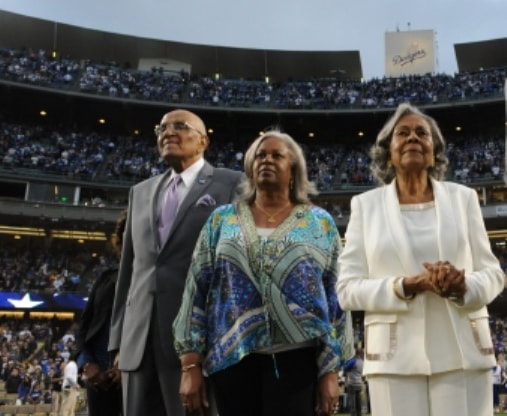|
Much has been made – deservedly – about what Don Newcombe accomplished on the field but much less has been written about how he saved lives.
Newcombe, who died this week at 92, put himself out there, as the rugged face of beating back addiction, day by day. He was one of the first public figures to talk about addiction – before Betty Ford, before other prominent people. Newk was at his most formidable around the Los Angeles Dodgers, his old team. He was the Dodgers’ “director of community relations,” which meant he spoke about race and addiction and good citizenship, offering himself as a prime example, how he had wrecked his career as a pitcher (and pinch-hitter deluxe), by drinking. He gave testimony of how he had gone sober, on his knees, promising his wife he would never drink again. The amazing thing about this tough guy is that he did it by himself – just stopped. Most alcoholics rely on daily reinforcement, the meetings, the written word, the prayer to a higher power. Newk just stopped. This guy was so tough, he would not take gas or injections at the dentist, to deaden the pain. He never went to a rehab center, never went to AA meetings for himself, but he did not recommend that path for anybody else. He told other people that rehab worked, and that they should seek it, and sometimes he accompanied them right into the center. He also stalked players, or at least they thought he did. My friend Bob Welch was having blackouts at 23, destroying a promising pitching career, and his life, during the 1979 season. When I helped him write his book about rehab – “Five O’Clock Comes Early: A Young Man’s Battle With Alcoholism,” Bob told me how he hated Newcombe, was sure Newk was stalking him. And maybe Newk was. A big man, 6-foot-4, 220 pounds, with a prominent jaw and nose making him even more formidable, Newk had the run of the ball park. He wore elegant suits and snappy straw fedoras and would wander through the clubhouse, chatting with people. He was hearing how Bob had passed out in public, how the Dodgers had sent somebody to get him into his hotel room. At the end of the 1979 season, the Dodgers had a program with a major sponsor, and staged an intervention with Bob, and got him to The Meadows in Arizona. Bob came back and pitched for more than a decade and won the Cy Young Award with Oakland; he was sober when he passed suddenly in 2014. Newk was also there for Maury Wills when his life was crumbling and for Lou Johnson, the heart of the 1965-6 team, who came to the Dodgers for help. Newk said: “We’ve been waiting for you.” Newk made public speeches, represented the National Institute on Alcohol Abuse and Alcoholism and other outfits dealing with addiction. In between, he spoke about Jackie Robinson and Roy Campanella, his teammates and would-be mentors in Brooklyn. He told of the night that Robinson got weary of the black hotel in St. Louis with no air conditioning, and said, that’s it, I’m checking in at the Chase, with the white Dodgers, and did just that. Jackie and Campy died young; Newk carried their flames; he did it his way, as the song goes. In 1987, just before the 40th anniversary of Robinson’s debut, Al Campanis, the Dodger general manager (who was my friend), made some foolish and meandering statements about how black players lacked the “necessities” to be managers. This was a chance to say, well, racism is everywhere, you never know about people, but Newk knew Al Campanis, knew how Al had taught Robinson to play second base in the minors in 1946, knew that Al hung out with Latino scouts at the ballpark. During the uproar, Mike Francesa and Christopher Russo interviewed Newk on WFAN radio. and Newk said Campanis was no racist, he just bumbled a bit, and he labelled the end of Al’s career a “tragedy.” Newk was loyal to the truth as he knew it. In recent years, whenever I thought of the Los Angeles Dodgers, my last link to Brooklyn was the big man in the elegant suits who had the run of Dodger Stadium. Newk was a staple on old-timers’ day and other days of remembrance but he was as courant as the latest celebrity caught abusing one thing or the other. We have lost a good one. * * * Richard Goldstein’s obituary on Newk: https://www.nytimes.com/2019/02/19/obituaries/don-newcombe-dead.html Newk and Lou Johnson: https://www.nytimes.com/1981/07/14/sports/johnson-ex-dodger-tells-of-cocaine-habit.html Newk and Maury Wills and others: https://www.dodgersnation.com/don-newcombe-proud-of-his-accomplishments-in-the-community/2015/04/17/ Newk’s stats: check out the batting average and the home runs. The Dodgers usually have good hitting pitchers – the real baseball, none of this DH foolishness: https://www.baseball-reference.com/players/n/newcodo01.shtml Another view of Newk’s work with the Dodgers: https://www.mercurynews.com/2019/02/19/one-evening-with-don-newcombe-his-important-message-his-long-odds/
George
2/21/2019 07:18:18 am
Joe: any friend of Mike’s....
Hansen Alexander
2/21/2019 02:18:01 pm
George,
George Vecsey
2/21/2019 08:27:28 pm
Hansen: Welchie didn't remember stuff. Started fights around the ball park, with opponents, for no reason. At family week, people told him stuff he did not remember. He was sober by the time I met him for a NYT article, spring of 1980. Comments are closed.
|
Categories
All
|










